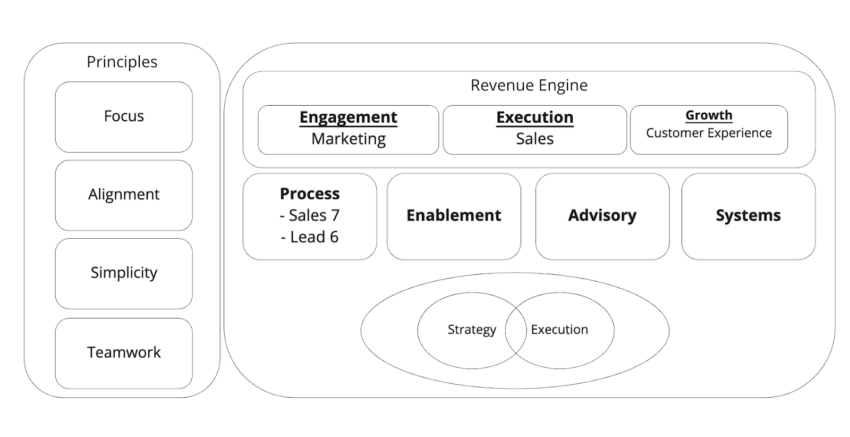How to Create Better Capacity Planning for Sales and Sales Operations
A playbook for Revenue Operations is required to support Marketing, Sales, and Customer Success successfully. Supporting the Head of Sales requires mastering The Sales 7: seven core areas: planning, territories, quotas, forecasting, incentives, systems, and process. There’s a time and place for unlocking each of the capabilities.
For startups, going too deep into any of these areas will be overkill. For longstanding enterprises, there will be entire teams with specialists who own a small sliver of each workstream. Earlier stage companies will be forced to make trade-offs as they are busy designing the engine while flying the plane; the depth and quality of the work will not be as thorough compared to their enterprise counterparts.
As the business grows, these capabilities become more extensive, and role specialists start to fill the Operations ranks. I hope that this guided series for the business will help you think through evolution in scaling.

Revenue engine framework: PEAS focus areas and FAST principles
A useful tool for headcount planning and execution is what I call the Three C’s (3C): capacity, coverage, and capability. In this article, we’ll focus on one of the most important sales planning items: capacity. Developing an understanding of capacity all along the funnel will better equip operations teams to better-supporting Marketing, Finance, and Customer Success. Covering all of the areas below would take an entire book, so we’ll focus on a small sliver geared towards earlier stage companies.
The First C: Capacity
Much like the floor of a manufacturing facility, the goal is to find the perfect balance of capacity and output. The key focus for sales teams is to perform the right activities to yield maximum revenue most efficiently. The first C of the 3Cs is capacity. Breaking this down further, we’ll optimize capacity for headcount, time management, territory size, and lead volume.
Headcount
Sales leaders need to know they have sufficient bench strength to achieve targets. Key factors to consider are expected attrition, ramp time, and time to hire. People leave their roles for various reasons, including finding better jobs, moving away, or getting promoted. This is the nature of business and should never be ignored. Backfilling critical roles is important because it takes time to post a requisition, interview, offer, and ramp-up new hires.
Revenue Operations helps to build out a headcount planning model factoring in these considerations. Aside from looking at roles in a silo, the headcount number will also require a look at supporting casts such as overlay roles and managers. Depending on which benchmarks are used, AEs-to-SDRs can range from a 3-to-1 to a 2-to-1 ratio. Sales reps-to-managers can sit between the 8-to-1 to a 6-to-1 ratio. When it comes to capacity planning, the macro factor starts with bringing in the right people.
Time management
Let’s face it: humans aren’t robots. We need to sleep, eat, and have lives outside of work. Sales productivity is, therefore, limited by the finite hours available to the business. Using time wisely is paramount for sales success. Every call, in theory, would feature research, call preparation, and a meeting structure. But that doesn’t always happen.
Revenue Operations can perform a time audit. Breaking down sales rep calendars between selling and non-selling activities will usually result in one of two hypotheses.
The first is that selling activities are too voluminous to provide a high-quality sales motion. In this case, the team does not have enough capacity. Dividing territories or reassessing segmentation allocation can be useful here.
The second outcome is that non-selling activities may be overly cumbersome. Keying in on process improvements such as system automation can give time back to sales reps.
In either situation, the time audit can and will lead to deeper personalization for enterprise selling motions. For transactional motions, it will provide thawed out call blocks.
Territory size and lead management
Sales reps can only focus on so many accounts within a year without compromising their effectiveness in outreach. Managers will often find shallowly developed account plans for their team’s top tier accounts. A lack of preparation in these areas is a canary in the coal mine for whole batches of accounts not receiving attention. Sales reps simply cannot service the size of the territory given to them. Revenue Operations can help recalibrate territory sizes.
The same goes for sales development reps with inbound leads. Effective call management requires dedicated time to research, prepare, and execute. Typically, the larger the organization sought after, the more front-end work is needed. SDR managers will find themselves examining how many leads are simply too many for anyone SDR to reasonably handle. Revenue Operations provides an evidence-based capacity assessment. A solution to consider is to increase the size of the team or prioritize leads so that only the ones of highest priority are pursued.
Setting up for success.
Sales or Revenue Operations practitioners do not have to specifically use these frameworks, but having a model will serve as a roadmap for both the head of sales and support teams. Every year the business will need to evaluate if it has enough capacity to meet its revenue targets. Capacity needs to be further broken down into actionable decisions ranging from headcount to time management. Experienced leaders will be able to leverage mental maps to their new situations. Operations leaders must come in with a perspective. Use the Sales 7 as a starting point, and best of luck with your annual planning.